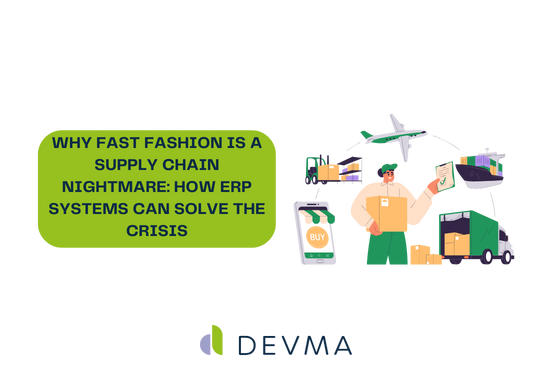Last update: Nov 19, 2024
Why Fast Fashion Is a Supply Chain Nightmare: How ERP Systems Can Solve the Crisis

Table of contents
Ever wonder how brands like Zara, H&M, and Shein seem to have the latest trends almost before they’re even trends? That’s fast fashion for you—cheap and fast production that rotates new collections into stores constantly. But behind that quick turnaround is a supply chain that’s, well… completely chaotic. Short lead times, unpredictable demand, truly massive amounts of waste—these are the nightmares that fast fashion brands reap from their trends. They thrive on getting designs from the runway to stores within weeks. But this rush to market brings big challenges that we’ll go over in this discussion.
Moving Forward: The Future of Fast Fashion with ERP
As the demand for speed in fashion continues to rise, the pressure on supply chains will only increase. But the good news is that ERP systems are evolving, becoming even more efficient and flexible.With AI-driven demand forecasting and real-time tracking, these systems are making it easier for fast fashion brands to stay agile, sustainable, and profitable.
While the supply chain is often viewed as a ticking time bomb, the implementation of ERP solutions can help diffuse the crisis. These systems give brands the tools they need to optimize their operations, reduce waste, and better respond to the unpredictable whims of fashion trends.
Controlling The Fast Paced Chaos
Implementing an efficient ERP system can be the lifeline fast fashion brands need to overcome these supply chain nightmares. Here’s how they do it:
- Real-Time Data and Demand Forecasting
ERPs provide real-time access to sales and inventory data, helping brands make more accurate demand forecasts. By integrating point-of-sale (POS) data and historical trends, ERP platforms allow companies to anticipate which products will sell quickly and which will lag. This visibility minimizes both overstocking and stockouts, reducing waste and improving profitability. - Streamlining Production and Inventory
Centralizing data from different departments (sales, production, and logistics) into one unified system. This means that when a designer finalizes a new collection, everyone from suppliers to warehouse managers knows about it. Real-time updates ensure that inventory levels are always accurate, and replenishment is automated to avoid unnecessary delays. ERP systems can track raw materials and finished goods throughout the production cycle, cutting down on miscommunications and inefficiencies. - Supply Chain Transparency
Brands can track orders, shipments, and production schedules in real time. This level of visibility helps prevent bottlenecks and allows companies to pivot quickly when delays occur. For instance, if a supplier is delayed, the ERP system can notify key stakeholders immediately, allowing for rapid adjustments to production schedules or shipping methods. - Sustainability and Waste Reduction
It offers tools for managing sustainability efforts more effectively. By optimizing inventory management and production planning, ERP systems help reduce waste and overproduction. Additionally, many ERP platforms offer features for tracking environmental impact, such as energy consumption and carbon emissions, allowing fashion brands to take proactive steps toward a greener supply chain.
In an industry that moves at the speed of social media trends, you need tools that can keep up. ERP solutions offer the control and insight to navigate the complexities of fast fashion’s supply chain. They turn chaos into clarity.
So if you’re in that fast fashion game and all that sounds good (which we know it does), it’s time to give ERPs a serious look. Your supply chain (and your sanity) will thank you.